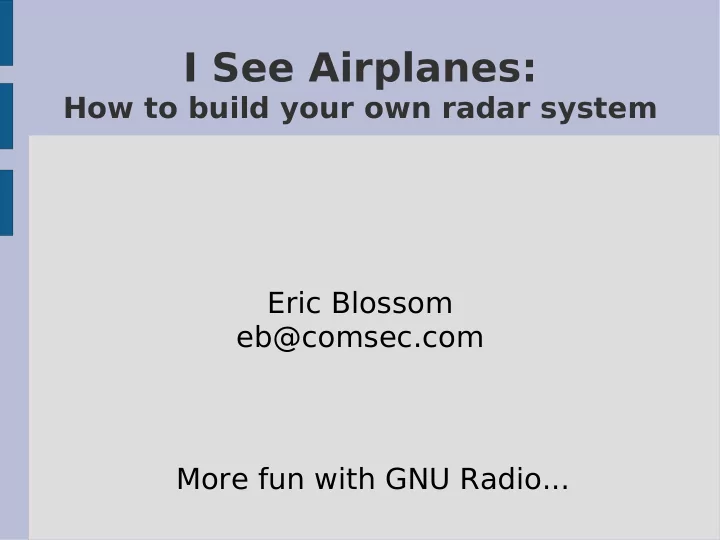

I See Airplanes: How to build your own radar system Eric Blossom eb@comsec.com More fun with GNU Radio...
What is radar? ● “Radio Detection and Ranging” ● Watches the reflection of radio waves off of objects and figures out: – How far away – Velocity of object – Bearing (direction) to object – Type of object (classification)
A bit of history ● First radar 1904 Christian Helsmeyer: – Spark gap; 40 – 50 cm; detected ships ● First unambiguous bistatic detection: – Sept 1922, Holt & Young, 50W 60 MHz – Observed reflections from trees and wooden steamer (boat) ● UK 1935 “Daventry experiment” – Demonstrated aircraft detection ● WWII, ...
Airport surveillance radar
PAVE PAWS
Busted!
Radar configurations ● Monostatic ● Bistatic ● Multi-static (networked)
Bistatic radar ● Transmitter & Receiver are at different locations. ● Original motivations: – Avoiding anti-radiation missles – Remote target illumination
Bistatic triangle
Bistatic doppler
Bistatic radar equation
Passive radar ● A subclass of of Bistatic Radar ● Use somebody else's transmitter!
For example...
The basic idea ● Use other people's transmitters ● Use multiple coherent receivers ● One or more Tx and/or Rx locations ● Watch reflections ● Do a bunch of math ● Detemine position and velocity
Choice of transmitter ● Don't control signal, but know the general characteristics ● Obvious choices: – Broadcast FM (100 kHz wide) – Analog and/or digital TV (6-8 MHz wide) – GSM cellular / UMTS ● Other choices: – High power satellites (DBS) – GPS satellites – Existing radar transmitters ● Primary and/or secondary surveillance
Existence proofs: ● Lockheed “Silent Sentry” ● Manastash Ridge Radar
Lockheed “Silent Sentry”
Manastash Ridge radar ● University of Washington – Prof John Sahr & students – Interested in ionospheric phenomenon ● Very simple ● Two locations separated by 150 km ● Takes advantage of mountains ● GPS synced time references ● Sees stuff up to 1200 km away!
What we chose ● FM broadcast – About 100 MHz (3m wave length) – Bandwidth about 100 kHz – Theoretical distance resolution 3 km ● (but see also “super-resolution” techniques) ● Why: – Simplest h/w that could possibly work. – Need to sample multiple antennas coherently. – Bandpass sampling eliminates requirement for coherent analog LO
Universal Software Radio Peripheral (USRP) ● 4 12-bit 64 MS/sec A/Ds ● 4 14-bit 128 MS/sec D/As ● Altera Cyclone FPGA ● USB 2 interface to PC ● Pluggable RF daughterboards ● See http://ettus.com for info
USRP block diagram
Bandpass sampling ● Nyquist sampling criterion: – Need 2x the bandwidth of interest ● USRP samples at 64 MS/s ● spectrum “folding” every Fs/2 (32 MHz) ● therefore, folds at 96 MHz, middle of FM band. ● Requires bandpass filter to avoid aliasing. Either: – 87 – 95 MHz or – 97 – 107 MHz
Experimental setup ● Simplest thing that could possibly work ● 2 directional antennas – 1 pointed at Tx about 45km away – 1 pointed about 120° away (towards airport approach) ● 2 broadband LNA's ● 1 USRP with 2 “Basic Rx” d'boards
Procedure ● Watch for nearby airplanes ● Collect the data ● Run the analysis software ● Plot the range/doppler graph
Airplanes?
Hmmm... ● Could be h/w or s/w or both... ● Could be RF/Analog – Filtering – Gain – Antennas – Direct path overwhelming reflection (not enough dynamic range) ● Could be signal processing s/w – Is it working?
Simulate! ● Simulate the FM transmitter ● Simulate the radar reflections – Geometry (Tx, Rx, targets: pos & velocity) – Propagation delay – Doppler shift ● Run analysis s/w on reference signal and simulated returns.
I see (simulated) airplanes!
Next steps ● Quantitative analysis using simulator: – What RF performance do we require for s/w to be able to detect targets? – How small (big?) of an object should we expect to see at a give distance ● Design & build low-loss bandpass filters – Probably helical filters ● Antenna ideas: – Dipoles in front of metal screen – “Corner reflectors”
And then... ● Determine angle of arrival – Interferometry / phased array – Watch multiple Tx's in different locations – Use multiple Rx's in different locations ● Target tracking (multiple targets) ● Nice real-time application with GUI ● Try it with digital TV signals – Theoretical ~50 m resolution
Resources ● The code is in GNU Radio CVS ● http://www.gnu.org/software/gnuradio ● Mailing list: discuss-gnuradio@gnu.org
Questions?
Recommend
More recommend